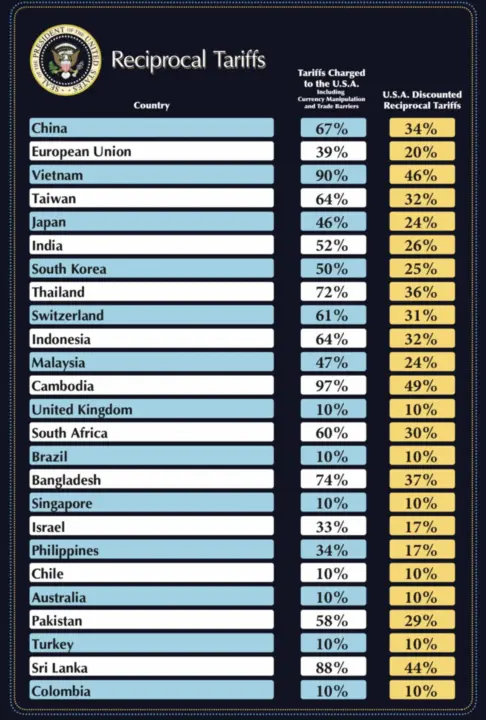On April 2nd, 2025, President Donald Trump made good on one of his boldest economic promises yet—he launched a new reciprocal tariff system aimed at ending decades of one-sided trade deals that hollowed out American manufacturing and handed our leverage to foreign nations.
The Left, as expected, dubbed it “Obliteration Day,” painting it as economic suicide. But while the mainstream media churned out panic and Wall Street trembled, blue-collar America, small manufacturers, and strategic thinkers saw something else:
A long-overdue correction. A reckoning. A rebalancing.
Liberation Day.
Let’s break down what this actually means—for the economy, for trade, for global relations—and why you’re not hearing the truth from CNN.
What Are Trump’s Tariffs, Really?
This isn’t just another campaign promise. It’s an aggressive, calculated economic policy shift aimed at restoring fairness to trade. Trump’s April 2025 executive action includes two tiers:
-
Universal Tariff: A 10% base tariff on all imports from all nations, effective April 5.
-
Reciprocal Tariffs: A second wave of country-specific tariffs starting April 9—each set in proportion to how much those nations tax or restrict U.S. exports.
That’s what “reciprocal” means: You tax us, we’ll match you—fairly.
To drive the point home, Trump released the following chart during his announcement, showing what these countries charge the U.S. vs. the discounted reciprocal rate we’re now charging them:

Look at the numbers. While countries like Vietnam charge us 90% tariffs, we’re only hitting back with 46%. Even China, which piles on a 67% tax burden through tariffs and barriers, will face only 34% under our new policy.
This isn’t a trade war. This is America finally setting boundaries.
The Reason Behind the Reset
Trump didn’t wake up one day and decide to slap tariffs on the world. This policy stems from years of ballooning trade deficits and deliberate exploitation of America’s open-market generosity.
-
In 2024, the U.S. recorded a $1.2 trillion trade deficit, the highest on record.
-
With China alone, the deficit was $320 billion.
-
U.S. manufacturing’s share of global output fell from 28.4% in 2001 to 17.4% by 2023.
-
5 million manufacturing jobs lost since the late ‘90s.
These are not just numbers—they are shuttered factories, boarded-up towns, and middle-class dreams exported overseas. The goal of this tariff reset is to revitalize American manufacturing, restore industrial independence, and ensure that America is never again reliant on adversaries for steel, semiconductors, or pharmaceuticals.
What the Left Gets Wrong
Let’s tackle the fear-mongering head-on.
Claim #1: This Will Cause a Global Meltdown
No, it won’t. The U.S. is the biggest, most valuable consumer market in the world. Most of these countries need access to our market more than we need theirs. The tariffs are a pressure valve—not a shutdown.
Claim #2: Prices Will Skyrocket
In the short term? Maybe. But long term, the goal is domestic competition, local supply chains, and price stability. You get that by rebuilding American industry—not depending on cargo ships from Shanghai.
Claim #3: This Will Start a Trade War
We’ve been in a trade war for years—we just weren’t fighting back. This is us finally getting off defense.
What the World Is Saying
As expected, world leaders are clutching their pearls. Here’s the rundown:
-
China announced retaliatory tariffs but also hinted at negotiations. They know they can’t afford to lose U.S. buyers.
-
The EU is “concerned” and considering countermeasures. But with Germany’s economy already sputtering, they’re walking a tightrope.
-
The UK is looking for exemptions, particularly for autos—showing these tariffs are already driving countries to the table.
-
Vietnam, hit with the highest tariff (46%), has said it will seek “constructive dialogue” with the U.S.
Let’s be clear: This isn’t chaos. This is leverage.
How It Helps Americans
-
Encourages American-made goods by leveling price differences.
-
Creates domestic jobs by making U.S. factories more competitive.
-
Secures critical industries like steel, aluminum, energy, and semiconductors.
-
Protects national security by reducing dependency on foreign supply chains.
Manufacturing is still the engine of innovation in this country. It drives 70% of our R&D and 55% of patents. Every manufacturing job supports 7–12 other jobs in the economy.
This isn’t protectionism—it’s common sense.
Why “Liberation Day” Is the Right Name
The Left’s “Obliteration Day” rhetoric is more of the same tired panic they trotted out when Trump cut taxes, opened oil production, and secured the border. And just like those moves, this one is based on America First.
This is about liberating our economy from the grip of global dependence.
Liberating workers from the pain of unfair competition.
Liberating our nation from the fantasy that we can consume but never produce.
The Bottom Line
-
We’ve been exploited by one-sided trade for decades.
-
Trump’s tariffs are reciprocal, targeted, and smart.
-
They protect U.S. jobs, industries, and sovereignty.
-
The panic is political—the policy is patriotic.
Trump didn’t destroy the global order—he finally stood up for America’s interests in it.
Let the globalists wail. Let the media meltdown. Let Wall Street sweat.
Main Street just got a fighting chance again.
WE’D LOVE TO HEAR YOUR THOUGHTS! PLEASE COMMENT BELOW.
JIMMY
Find more articles like this at steadfastandloyal.com.
h/t: Steadfast and Loyal


Expand tariffs all the way